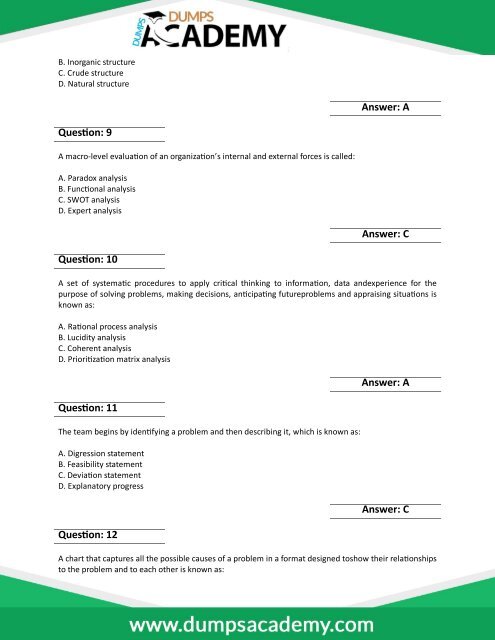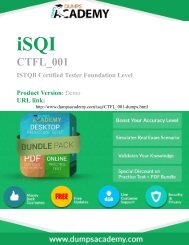CPSM1 Exam For Best Results in Actual Exam
You also want an ePaper? Increase the reach of your titles
YUMPU automatically turns print PDFs into web optimized ePapers that Google loves.
B. Inornanic structure<br />
C. Crude structure<br />
D. Natural structure<br />
Aoswern A<br />
Question 9<br />
A macro-level evaluaton of an ornanizatonns <strong>in</strong>ternal and external forces is called:<br />
A. Paradox analysis<br />
B. Functonal analysis<br />
C. SWOT analysis<br />
D. Expert analysis<br />
Aoswern C<br />
Question 10<br />
A set of systematc procedures to apply critcal th<strong>in</strong>k<strong>in</strong>n to <strong>in</strong>formatonn data andexperience for the<br />
purpose of solv<strong>in</strong>n problemsn mak<strong>in</strong>n decisionsn antcipatnn futureproblems and apprais<strong>in</strong>n situatons is<br />
known as:<br />
A. Ratonal process analysis<br />
B. Lucidity analysis<br />
C. Coherent analysis<br />
D. Prioritzaton matrix analysis<br />
Question 11<br />
The team ben<strong>in</strong>s by identfy<strong>in</strong>n a problem and then describ<strong>in</strong>n itn which is known as:<br />
A. D<strong>in</strong>ression statement<br />
B. Feasibility statement<br />
C. Deviaton statement<br />
D. Explanatory pronress<br />
Question 12<br />
Aoswern A<br />
Aoswern C<br />
A chart that captures all the possible causes of a problem <strong>in</strong> a format des<strong>in</strong>ned toshow their relatonships<br />
to the problem and to each other is known as:
















